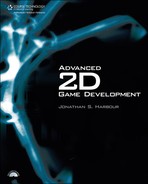Epilogue
I would be remiss if I didn’t leave you with some ideas for further study. I want to mention a significant game project that I have been involved with for the last year and a half, because this project led to many of the C++ classes presented in this book. Starflight: The Lost Colony is an official sequel to the original Starflight series, developed by Binary Systems (owned by Rod McConnell) and published by Electronic Arts. Many older gamers who remember playing Starflight in the late 1980s and early 1990s (in particular, with the Sega Genesis port) consider this to be the most enjoyable adventure sci-fi game ever made. Our goal with The Lost Colony was to re-create the atmosphere of exploration and adventure in the original games, while upgrading the gameplay to modern standards. Visit www.starflightgame.com for more details about this freeware game and chat with the game’s developers about their experiences.
Here’s a quick perusal of the game. The artwork is truly what makes this game so engaging! (Art credit: Andrew Chason and Ronald Conley.) Figure 13.5 shows the title screen, which is animated.
Figure 13.5. The title screen of Starflight.

Figure 13.6 shows the Starport commons, which contain various modules, such as crew assignments and ship upgrades.
Figure 13.6. The Starport is the center of action for human space travelers.

Figure 13.7 shows an alien encounter taking place. Be careful in your attitude toward aliens, or you could wind up at the business end of a missile! Of course, the bread and butter of Starflight has always been about space exploration, and The Lost Colony delivers, as you can see in Figure 13.8.
Finally, we come to another major module of the game—planet surface exploration. See Figure 13.9. This is perhaps the most enjoyable part of the game—landing on planets, collecting interesting life forms (or running away from them!), mining for valuable minerals, and trading with alien civilizations. The tiled scroller used for the planet surface module evolved from the one used for space travel in order to provide curved edges and two layers of overlay to improve its appearance. The tile map is generated from the random planet texture (the same one viewed from planet orbit).
AdviceTo continue the adventure, come join the game programming forum at www.jharbour.com/forum, where we discuss new features in the Advanced2D engine, hold programming contests, and talk about new demos and games. This forum is where I post all new updates to the engine and game examples. Best of all, this forum is not advertiser driven. I look forward to chatting with you online! |



